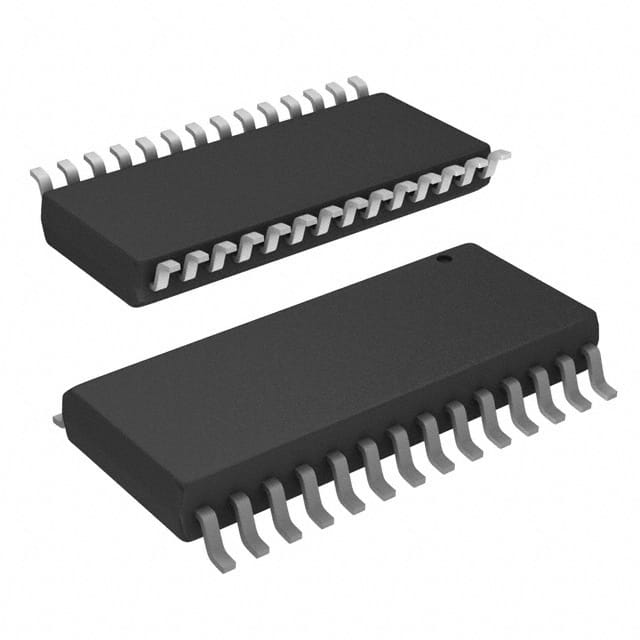Подробную информацию о продукте см. в характеристиках.

PIC16F723A-I/SO
Product Overview
Category
The PIC16F723A-I/SO belongs to the category of microcontrollers.
Use
This microcontroller is commonly used in various electronic devices and systems for controlling and processing data.
Characteristics
- High-performance 8-bit RISC architecture
- Flash program memory with self-read/write capability
- Low power consumption
- Wide operating voltage range
- Enhanced peripheral integration
- Flexible I/O options
- On-chip analog-to-digital converter (ADC)
- Timers and PWM modules
- Serial communication interfaces
Package
The PIC16F723A-I/SO is available in a small outline (SO) package, which provides ease of integration into circuit boards.
Essence
The essence of the PIC16F723A-I/SO lies in its ability to provide efficient control and processing capabilities in a compact form factor.
Packaging/Quantity
This microcontroller is typically packaged in reels or tubes, with a quantity of 250 units per reel/tube.
Specifications
- Architecture: 8-bit RISC
- Program Memory Size: 7 KB
- RAM Size: 256 bytes
- Operating Voltage Range: 2.3V to 5.5V
- Maximum CPU Speed: 20 MHz
- Number of I/O Pins: 18
- ADC Resolution: 10-bit
- Timers: 3
- PWM Modules: 1
- Communication Interfaces: USART, SPI, I2C
Detailed Pin Configuration
The PIC16F723A-I/SO has a total of 18 pins, each serving a specific purpose. The pin configuration is as follows:
- RA0 - Analog Input/Output
- RA1 - Analog Input/Output
- RA2 - Analog Input/Output
- RA3 - Analog Input/Output
- RA4 - Digital I/O
- RA5 - Digital I/O
- VSS - Ground
- VDD - Power Supply
- RB0 - Digital I/O
- RB1 - Digital I/O
- RB2 - Digital I/O
- RB3 - Digital I/O
- RB4 - Digital I/O
- RB5 - Digital I/O
- RB6 - Digital I/O
- RB7 - Digital I/O
- OSC1/CLKIN - Oscillator Input
- OSC2/CLKOUT - Oscillator Output
Functional Features
The PIC16F723A-I/SO offers several functional features that enhance its usability and performance:
- Flash program memory for storing user code
- EEPROM data memory for non-volatile storage
- Enhanced Capture/Compare/PWM (CCP) module for precise timing control
- Analog-to-Digital Converter (ADC) for analog signal processing
- Timers and counters for time-based operations
- Serial communication interfaces for data exchange with other devices
- Interrupt capability for handling real-time events
- Low-power modes for energy-efficient operation
Advantages and Disadvantages
Advantages
- High-performance RISC architecture ensures efficient execution of instructions.
- Wide operating voltage range allows compatibility with various power sources.
- Enhanced peripheral integration reduces the need for external components.
- Flexible I/O options enable versatile connectivity with external devices.
- Low power consumption extends battery life in portable applications.
Disadvantages
- Limited program memory size may restrict the complexity of applications.
- Relatively small RAM size may limit the amount of data that can be processed simultaneously.
- Lack of advanced features found in higher-end microcontrollers.
Working Principles
The PIC16F723A-I/SO operates based on the principles of a typical microcontroller. It executes instructions stored in its program memory, interacts with peripherals and external devices through its I/O pins, and processes data using its internal resources such as the CPU, memory, and communication interfaces.
Detailed Application Field Plans
The PIC16F723A-I/SO finds applications in various fields, including but not limited to:
- Home automation systems
- Industrial control systems
- Automotive electronics
- Medical devices
- Consumer electronics
- Internet of Things (IoT) devices
- Robotics
- Security systems
Detailed and Complete Alternative Models
For those seeking alternative microcontrollers with similar capabilities, the following models can be considered:
- PIC16F722A-I/SO
- PIC16F724A-I/SO
- PIC16F726A-I/SO
- PIC16F727A-I/SO
- PIC16F737-I/SO
These alternative models offer comparable features and performance, providing flexibility in choosing the most suitable microcontroller for specific applications.
Word count: 660 words
Перечислите 10 распространенных вопросов и ответов, связанных с применением PIC16F723A-I/SO в технических решениях.
What is the maximum operating frequency of PIC16F723A-I/SO?
- The maximum operating frequency of PIC16F723A-I/SO is 20 MHz.Can PIC16F723A-I/SO be used for motor control applications?
- Yes, PIC16F723A-I/SO can be used for motor control applications with its integrated PWM module.What are the communication interfaces supported by PIC16F723A-I/SO?
- PIC16F723A-I/SO supports SPI, I2C, and UART communication interfaces.Is it possible to program PIC16F723A-I/SO using C language?
- Yes, PIC16F723A-I/SO can be programmed using C language with the MPLAB XC8 compiler.Does PIC16F723A-I/SO have analog-to-digital conversion (ADC) capability?
- Yes, PIC16F723A-I/SO has a 10-bit ADC module for analog-to-digital conversion.Can PIC16F723A-I/SO be used in battery-powered applications?
- Yes, PIC16F723A-I/SO is suitable for battery-powered applications due to its low power consumption features.What are the available memory options in PIC16F723A-I/SO?
- PIC16F723A-I/SO has 3.5 KB of flash memory and 128 bytes of RAM.Is there an integrated watchdog timer in PIC16F723A-I/SO?
- Yes, PIC16F723A-I/SO includes an integrated watchdog timer for system reliability.Can PIC16F723A-I/SO be used in temperature sensing applications?
- Yes, PIC16F723A-I/SO can be used in temperature sensing applications with external temperature sensors.Are there any development boards available for PIC16F723A-I/SO?
- Yes, there are development boards specifically designed for PIC16F723A-I/SO, such as the Curiosity Development Board.

